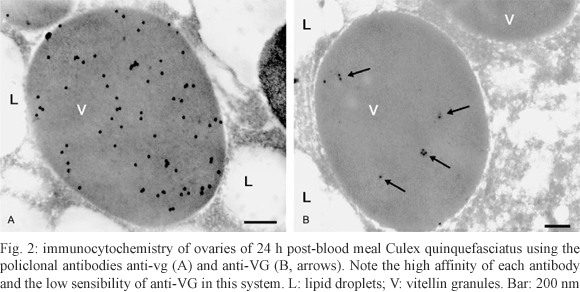The vitellogenic process in Culex quinquefasciatus, which is triggered by a blood meal, involves the synthesis, distribution and storage of the nutrients necessary for embryo development. The fat body of an adult female Cx. quinquefasciatus revealed two cell types: large trophocytes and small, eosinophilic, "oenocyte-like" cells, which show no morphological changes throughout the gonotrophic cycle. Trophocytes, which only begin to synthesise vitellogenin (Vg) 12 h post-blood meal (PBM), undergo a series of morphological changes following engorgement. These changes include the expansion of the rough endoplasmic reticulum (RER) and Golgi complex, which are later destroyed by autophagosomes. At 84 h PBM, trophocytes return to their pre-engorgement morphology. The ovarian follicles of non-blood-fed Cx. quinquefasciatus contain a cluster of eight undifferentiated cells surrounded by follicular epithelium. After engorgement, the oocyte membrane facing the perioocytic space increases its absorptive surface by microvilli development; large amounts of Vg and lipids are stored between 24 and 48 h PBM. Along with yolk storage in the oocyte, follicular cells exhibit the development of RER cisternae and electron-dense granules begin to fill the perioocytic space, possibly giving rise to endochorion. Later in the gonotrophic cycle, electron-dense vesicles, which are possible exochorion precursors, fuse at the apical membrane of follicular cells. This fusion is followed by follicular cell degeneration.
Culex quinquefasciatus; vitellogenesis; immunolabelling; morphology; fat body; ovary








